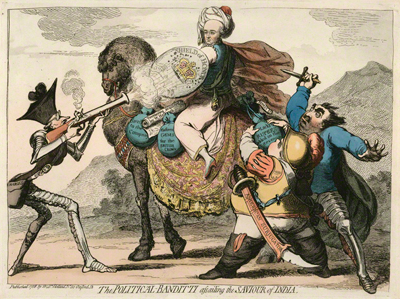Political Banditti Attacking the Saviour...
The East India Company had been an enormous source of trade and revenue for Britain during much of the 18th century. What began as a trading entity, however, had evolved into a vast administrative, military, and political organization as instability in the region threatened to disrupt business. Having joined the East India Company as a 17 year old clerk in 1750 and worked his way up to what was de facto the Governor-General of India, Warren Hastings had been intimately involved in this evolution. And he was the lightning rod for any criticism of the East India Company as the British government wished to exert greater control over the company and its practices.

© National Portrait Gallery, London
By 1786 criticism that had been simmering for some years reached the boiling point in formal impeachment charges brought against Hastings before the House of Commons just a week after this print appeared. They were read over two days by Edmund Burke and supported by the opposition led by Charles James Fox, Frederick Lord North, and Richard Brinsley Sheridan, partly to embarrass the Crown and Pitt administration which had been previously supportive of Hastings.
In Political Banditti Attacking the Saviour of India, Gillray presents (at this point) a quite positive view of Hastings, seated on a majestic (if anatomically impossible) horse/camel, his serene, uncaricatured face looking down upon his attackers from the clear space between two clouds. He carries a map labeled "Territories acquired [for Britain] by W. Hastings" and saddle bags labeled "Eastern Gems for the British Crown" and "[Moneys] Saved to the Company".
On the other hand, Gillray portrays the opposition as caricatures of Banditti (in the manner of John Hamilton Martimer, who had made Banditti subjects popular in England). Burke with a trademark biretta (marking him as a crypto-Catholic) fires a blunderbuss of "Charges" but they bounce harmlessly off Hasting's "Shield of Honor" featuring a British coronet. Not surprisingly, Fox is shown deviously attempting to stab Hastings from behind with a dagger, while Lord North with a battered sword and hilt labeled "American Subjugator" removes "Rupees" in an effort to frame Hastings.
This was only the beginning of the three-ring circus that became the Hastings impeachment trial. It lasted until 1795 and resulted in a financially ruinous acquittal of Hastings.
Sources and Reading
- Commentary from the British Museum on Political Banditti Attacking the Saviour...
- Draper Hill, The Satirical Etchings of James Gillray, 1976 #8
- Nicholas K Robinson, Edmund Burke: A Life in Caricature, 1996, Pl. 86
- "Impeachment of Warren Hastings," Wikipedia
- Thomas Wright and R.H. Evans, Historical and Descriptive Account of the Caricatures of James Gillray #31
Comments & Corrections
NOTE: Comments and/or corrections are always appreciated. To make that easier, I have included a form below that you can use. I promise never to share any of the info provided without your express permission.